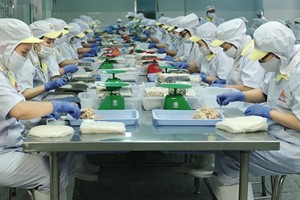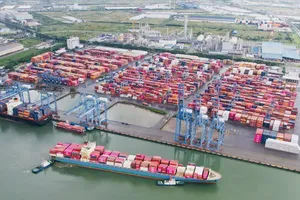
With the Lunar New Year nearing, VISSAN JSC. ramps up production, accelerating operations to meet surging domestic and international demand, especially for food products. The constant hum of packaging lines ensures efficient handling and warehousing of finished goods, contributing significantly to annual revenue through exports.
ChiliCa, a chili sauce producer exporting to Europe, the US, and Asia, prioritizes quality through a closed production process. They adhere to strict food safety standards from sourcing to distribution, guaranteeing their products exceed the stringent technical requirements of diverse export markets.
Vietnam’s key export commodities have consistently set new records in 2024. For instance, rice exports reached nearly US$5.3 billion, positioning Vietnam among the world’s leading rice exporters. Vietnam also maintained its second-place ranking globally in coffee exports, trailing only Brazil, with export turnover nearing $4 billion. Seafood exports reached $7.23 billion in the first nine months of 2024, placing Vietnam among the top three seafood exporting nations globally.
“Considering the 14.9-percent year-on-year increase in merchandise export turnover, we cannot help but feel proud of the efforts made by Vietnamese businesses. Many member companies of the HCMC Food and Foodstuff Association have filled orders through June 2025. Some companies have even confidently set a 30-percent revenue growth target for 2025,” cheerfully stated Chairwoman Ly Kim Chi of the HCMC Food and Foodstuff Association.
Remarkably, Vietnam has achieved impressive export successes, ascending to global leadership in several key sectors. The 2024 Global Innovation Index (GII) report, published by the World Intellectual Property Organization (WIPO), ranked Vietnam 44th out of 133 countries, a two-place improvement from 2023. Notably, Vietnam led the world in the Creative Goods Exports Index for the first time.
“The increasing diversity and quality of export products not only contribute significantly to export turnover but also affirm Vietnam's position on the global export map.”
Deputy Minister Phan Thi Thang of Industry and Trade
With the current growth momentum, the Ministry of Industry and Trade confidently asserts that Vietnam’s total import-export turnover in 2024 could reach $800 billion, marking a new record in the country’s international trade.
However, it is crucial to acknowledge the imbalance in merchandise export turnover between the domestic and foreign economic sectors, with the former accounting for only 28.1 percent of total export turnover.
Within the structure of the top 10 export product groups, telephones and components, along with computers and electronic products, lead in export turnover, reaching approximately $55 billion and $50 billion, respectively. These two sectors are concentrated among a limited number of foreign-invested enterprises.

Meanwhile, product groups with a majority of domestic enterprises, benefiting from abundant domestic raw materials such as textiles and garments, footwear, wood and wood products, and agricultural and aquatic products, have lower export turnover, ranging from $15-38 billion.
Vice President Tran Minh Hai of the Institute for Public Policy and Rural Development noted that while Vietnam has advantages in agricultural production, approximately 70-85 percent of agricultural exports remain in raw or semi-processed form. This stems from weaknesses and deficiencies in deep processing and post-harvest processing industries. Refined raw materials used in processing industries still rely on imports.
Statistics from the Ministry of Industry and Trade reveal that capital goods account for a substantial 93.7 percent of total import turnover, with machinery, equipment, tools, and spare parts comprising 47.3 percent, and raw materials, fuels, and supplies comprising 46.4 percent. Consumer goods account for 6.3 percent of total import turnover.
To enhance value and expand markets, investment in deep processing is essential. Therefore, it is necessary to promote investment attraction in deep processing and product diversification, particularly in the sector of agricultural and aquatic products, and the processing of raw materials for the food and foodstuff industries.
Vietnam’s Free Trade Agreements (FTAs) facilitate investment in deep processing and product diversification. Recent synchronized raw material zone planning, combined with innovative farming practices meeting global standards from production to processing, attracts foreign investment from international institutions and enterprises.
Localities must now prioritize adequate, green infrastructure and transparent investment policies to foster foreign enterprise entry. These efforts will enhance export value, solidify Vietnam’s global supply chain position, and advance its goal of becoming a leading processing hub.
To increase export value, Director Vu Ba Phu of the Vietnam Trade Promotion Agency shared that the Ministry of Industry and Trade has collaborated with local state departments and industry associations to support businesses in building, managing, and developing national product brands. They regularly organize trade promotion activities through showcasing national branded products at domestic and international exhibitions and fairs.
At each exhibition and fair, the Vietnam Trade Promotion Agency designs a distinctive ‘Vietnam Value’ booth specifically for export products. This serves to affirm the brand position of Vietnamese products, helping Vietnamese businesses expand markets, participate more deeply in the global value chain, and enhance competitiveness and brand value.
In 2024, the Vietnamese economy continues to be a destination for foreign investors. Statistics from the Ministry of Planning and Investment reveal that by November 2024, Vietnam had attracted nearly US$27.26 billion in total foreign direct investment (FDI), a 1.9-percent increase year-on-year.
Realized FDI capital is estimated at approximately US$19.58 billion, an 8.8-percent rise compared to this time last year. Notably, the processing and manufacturing industry led with total investment reaching nearly US$10.69 billion, accounting for 70.4 percent of total registered capital and a 26.3-percent growth compared to the same period in 2023.
























